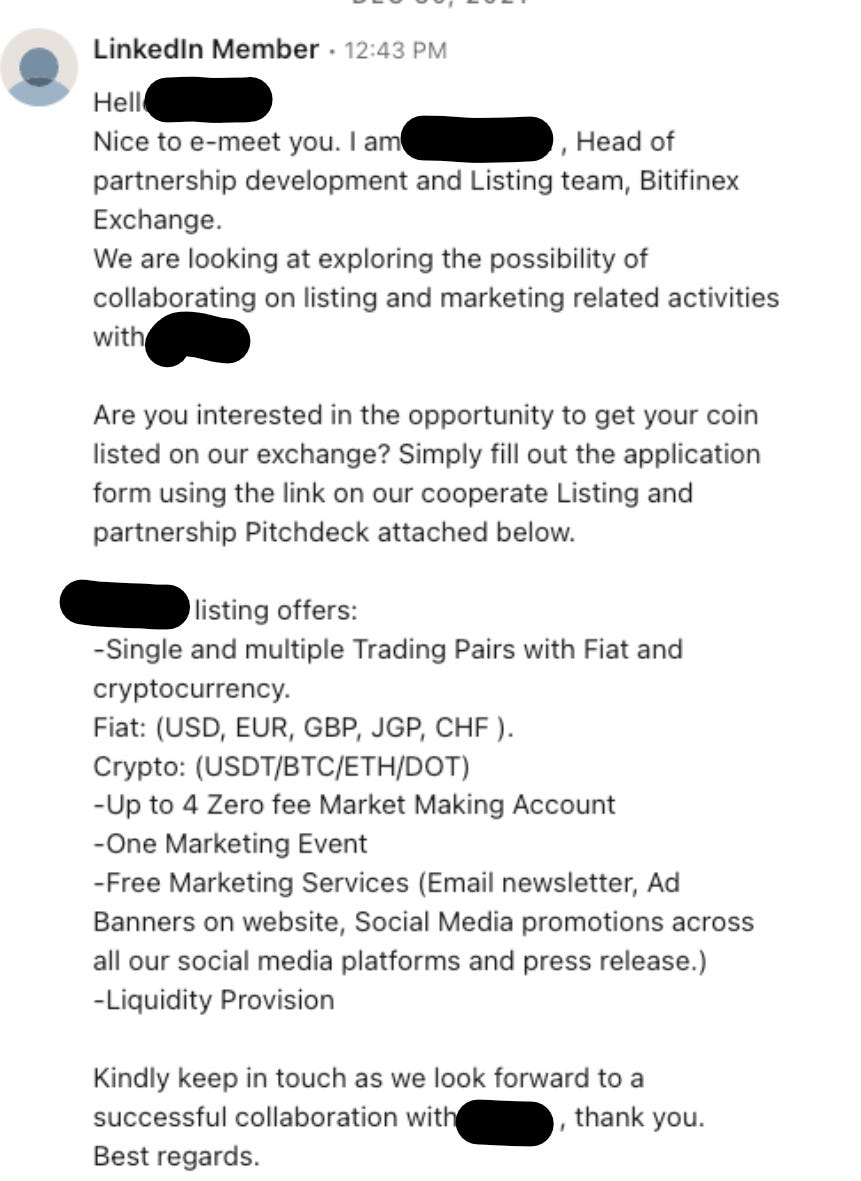Web3 Investor Scams Unveiled: Stay Safe, Stay Smart 🚨
The meme of the week
Guarding Against Investor Scams in Web3 Ventures 🛡️
Securing funds is a challenging endeavor for Web3 projects, particularly in the current economic climate where capital is hard to come by 💰.
The situation is exacerbated by the emergence of fraudulent investors who prey on these projects' financial needs. These fake investors present themselves as legitimate, leveraging the desperation for funds to execute their scams. As CEOs and CFOs of Web3 projects strive to secure the necessary funding, the threat of encountering scams by fraudulent investors is a pressing concern.
This article outlines the various scams orchestrated by fake investors and provides strategies to prevent such financial deceptions, ensuring a smooth journey towards achieving the project goals 🎯.
Progressive Engagement Tactics:
🔄 Fraudulent investors are masters of the long con. They initiate their engagement with a veneer of professionalism, often extending invitations for meetings or discussions 🤝. The engagement escalates progressively, drawing the victim deeper into their web of deceit.
They meticulously craft scenarios to demonstrate their “genuine” interest and commitment, even going to the extent of organizing physical meetings, sometimes across borders 🌍.
The objective is to create a facade of legitimacy and to emotionally and financially engage the victim further into their scheme. Such orchestrated engagements not only waste precious time but also drain financial resources, leaving the victims entangled in a web of false hopes and lost assets.
The Spectrum of Scams: 🎭
The Crypto Charlatan: • This fraudster portrays an interest in purchasing your tokens in exchange for another cryptocurrency 💱. The bait often involves a "test transaction" with a smaller volume, albeit significant for them, before proceeding with a larger volume. The twist? They either send a fake token or vanish post the test transaction 🪄.
You often meet them in crypto conventions !The Equity/Token Trickster: • A more sophisticated scammer, they engage you in an elaborate fake due diligence process. After investing substantial time, they concoct a narrative requiring the advance of certain fees (legal or otherwise) to unlock the promised funds, which, alas, never materialize 🚫.
When it's too good to be true, it usually isn't 🤔💭:
The Phantom Exchange: • Masquerading as a representative of a centralized exchange platform where you aspire to list your tokens, they coax you into paying listing fees in stablecoins or your project tokens. Once the fees are transferred, they ghost away 👻.
Bitfinex ? Why not…. but Bitifinex?The Executive Impersonator: • A classic scam transcending the digital divide: team members receive urgent emails from a fake CEO, as identified on LinkedIn. As the email exchange progresses, the imposter requests funds for some fabricated exigent circumstance 📧.
Investor Verification Strategies🔍 : KYC and KYB first
Navigating the investment landscape necessitates a blend of due diligence and skepticism. Here's how to tread cautiously:
Thorough Research: Delve into the background of potential investors. Utilize platforms like LinkedIn to check their professional history, mutual connections, and endorsements. Look for press releases, news articles, or any public information that corroborates their claims 📊.
Verification Services: Engage verification services to authenticate the legitimacy of potential investors : KYC and KYB first ! 🧾
Seek References: Request references from the investors and connect with those references to gather insights on their experiences and the credibility of the investors 📞.
Legal Consultation: Before entering into any agreements, consult with legal professionals to understand the implications and to ensure that all dealings are within the legal and regulatory frameworks ⚖️.
Use Secure Communication Channels: Employ secure and traceable communication channels for all interactions. Avoid sharing sensitive information over emails or messaging apps without verifying the identity of the recipients 🔒.
Community Interaction: Engage with the community of startups and share experiences regarding interactions with investors. Collective knowledge can serve as a powerful tool to identify and thwart potential scams 🤝.
Now, let's delve into a topic that's less frightening but just as crucial.
🎯 Contracting in the Web3 World
Mastering contractual relationships is the key to success. Whether you're engaging employees, freelancers, or bounty contributors, the when, how, and what to watch for can make or break your Web3 project. 🌐💼🚀
We'll explore the intricacies of contractualization, breaking it down into three key parts:
Part 1: Contracting with Employees
Part 2: Contracting with Freelancers and Independents
Part 3: Embracing Web3 Bounty Platforms
Each part will provide valuable insights into the best practices, nuances, and considerations for each mode of contractualization. So, let's dive into the exciting world of Web3 contracting! 🌟🌐🚀
Part 1: Contracting with Employees
When is it recommended?
🏢 Engaging employees is recommended when you need a committed, long-term workforce for your Web3 project.
💼 It's ideal for roles requiring physical presence, in-office collaboration, or consistent, predictable tasks. But also for managing and strategic roles.
How to go about it?
For Local Employees:
🌐 When contracting with local employees, we highly recommended to consult with a specialist or legal advisor experienced in local labor laws, employment contracts, and payroll regulations.
🧾 These experts can help you craft comprehensive employment contracts that adhere to all legal requirements, ensuring the protection of both you and your employees.
For Remote Employees:
💼 Engaging remote employees becomes simpler and more cost-effective when using specialized remote work platforms such as Remote.com, Deel.com and Oysterhr.com. They cover more than 100 countries in the world.
🚀 These platforms handle payroll, compliance, and benefits administration, making the process efficient and reducing administrative burdens for both employers and employees.
💰You will pay between 500 and 600 $ a month for every employe. It is therefore important to include it in your budget.
BONUS : access the benchmark we made on G2.com
Points of Attention
📈 Consider the implications of local labor laws and tax regulations, which can vary significantly from one region to another. That's why the mentioned platforms above are interesting, as they rely on carefully selected local partners.
💻 It's not exactly a contracting issue, but it's a real pain point for ops teams : how to manage an employee's equipment at a distance of 6000 kilometers? The good news is that several startups offer turnkey equipment management solutions: Firstbase , Hofy and Workwize.
Part 2: Contracting with Freelancers and Independents
When is it recommended?
💪 Engaging freelancers is recommended for short-term, project-specific tasks or unique, specialized skills.
🚀 It's the way to go when you need fast onboarding and minimal bureaucracy for rapid Web3 prototyping or specific expertise.
💡 Access a vast, diverse talent pool worldwide more easily.
How to go about it?
Direct Contracting:
🧾 When contracting directly with freelancers, start by creating clear, comprehensive contracts that outline project scope, deadlines, payment terms, and intellectual property rights. Our recommendation is to have a Services Agreeement drawn up by a competent lawyer to secure the collaboration.
🚨 Be particularly attentive to intellectual property clauses for all professions related to this subject: designers, graphic designers, UI designers, art directors, etc. Many conflicts can arise when your project has become a success.
Using Freelance Platforms:

💼 For a simpler approach, consider utilizing specialized freelance platforms like Upwork, Fiverr, Freelancer.com , Toptal or Malt.
🌐 Post your project with detailed descriptions of your needs, budget, and required skills on these platforms.
📥 Receive proposals from freelancers and evaluate their profiles and offers.
💻 Engage in discussions to clarify project details and select a freelancer who aligns with your project requirements.
Points of Attention
😏 Keep in mind that freelancers may not commit to long-term work, so plan for potential turnover or availability issues.
💤 As the project manager, you will bear responsibility for quality control and efficient management.
🧾 The platforms handle the contracting, but we recommend contracting separately with your own NDA and/or intellectual property agreement in addition.
Part 3: Embracing Web3 Bounty Platforms
When is it recommended?
🪙 Consider bounty platforms for web3project-specific tasks without long-term commitments, especially for cost-efficient solutions.
💰 This is very suitable for DAOs and very popular in the blockchain security thanks to Bounty Bugs platform.
How to go about it?
🌐 For all kinds of bounties, you can create your project on Dework. 777 DAOs are already using the platform.
🔐 For bug bounties, you can use platforms such as Immunefi, Hackenproof
Points of Attention
⚖️ Be prepared to navigate the complexities of tokens payments including legal and compliance issues.
🤯 Managing contributors from different time zones and cultures can pose coordination and communication challenges, so use project management tools to streamline workflows.
Conclusion
In this guide, we've equipped you with the knowledge and insights to navigate the complex world of Web3 contracting. Whether you're engaging employees, freelancers, or leveraging bounty platforms, below is a decision tree to help you make informed choices. This toolkit ensures you have the right reflexes for choosing the optimal contracting approach to make your Web3 project a success. 🌐💼
You can download the logical tree here.
If you enjoyed this edition and haven't subscribed yet, now is the time to do so. Thank you for reading and your support. 🙏
If you like our work, feel free to like and comment.
Follow us on Linkedin to keep up with all our news.
Disclaimer : The goal of this newsletter is to inform and produce content related to management in the world of Web3. It is not investment advice. Investments in crypto-assets and NFTs are risky and can result in the loss of your entire capital. Always conduct your own research and exercise caution.












